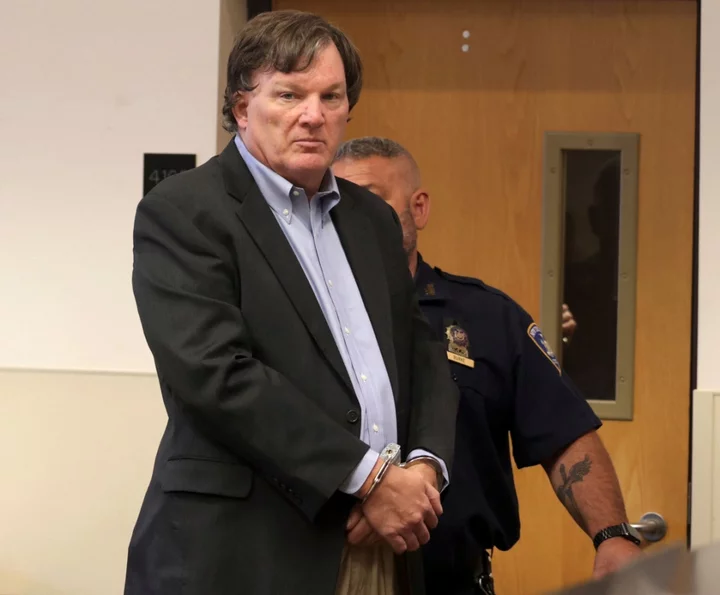
Gilgo Beach murders - live: Long Island police identify Jane Doe 7 but won’t comment on link to Rex Heuermann
The Gilgo Beach murders victim previously known only as Jane Doe 7 has finally been identified more than 26 years after her partial remains were first discovered along the Long Island shores. In a press conference on Friday, Long Island officials announced that they had identified the victim as Karen Vergata. Vergata, a 34-year-old woman, was last seen alive in Manhattan in 1996 while working as an escort. Police refused to take any questions and would not comment on whether or not she is linked to serial killer suspect Rex Heuermann. This comes as prosecutors have asked the court to obtain a swab of DNA from Mr Heuermanna and as his wife broke her silence in her first interview since his shock arrest to reveal she is filled with “anxiety” and their two children “cry themselves to sleep” every night over the horror case. Mr Heuermann, 59, was arrested on 13 July and charged with the murders of Amber Castello, Megan Waterman and Melissa Barthelemy. He is also the main suspect in Maureen Brainard-Barnes’ killing. The women all went missing in 2009 and 2010 before their remains were found along Gilgo Beach. Read More Gilgo Beach serial killer suspect’s contact with wife revealed Daughter of Happy Face Killer launches GoFundMe for Gilgo Beach murders suspect’s wife Rex Heuermann’s defence buried in mountain of evidence as he faces court in Gilgo Beach murders case
2023-08-04 22:57
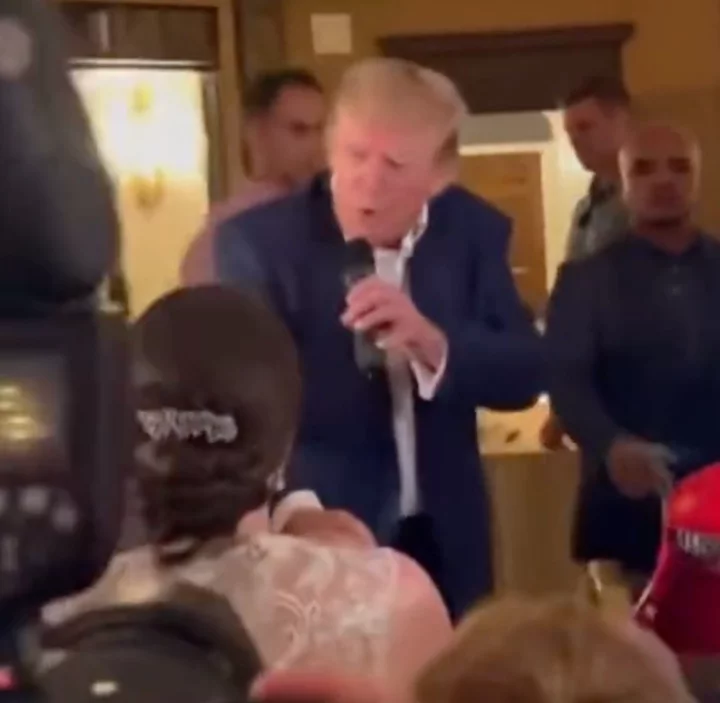
Trump moans criminal cases are keeping him from the campaign trail: ‘Must be Unconstitutional?’
Donald Trump is now complaining that the myriad of criminal cases against him are keeping him from the campaign trail, claiming that it must be “unconstitutional”. On Truth Social on Friday morning, Mr Trump moaned that President Joe Biden and Attorney General Merrick Garland had filed “bogus cases against me so it becomes difficult for me to campaign. Nothing like this has every happened before. Must be Unconstitutional? BUT SOMEHOW, WE WILL WIN IT ALL!!!” The investigation into Mr Trump is being led by Special Counsel Jack Smith, a role which provides the investigator with more independence. Also on Friday, Mr Trump hit out at Fox News, which he claimed was ignoring polls in which he leads President Joe Biden and primary rival Florida Governor Ron DeSantis. “Why is it that Fox & Friends refuses to put up all of the polls where I am beating Biden, and DeSanctimonious is getting clobbered? He’s also down to me by 40 plus points, and not coming back. No wonder their ratings are way down!!!” he wrote. Just before 8.30am on Friday, the morning after his arraignment in Washington, DC on four charges in relation to his attempts to overturn the 2020 election, Mr Trump wrote: “CRAZY! My political opponent has hit me with a barrage of weak lawsuits, including D.A., A.G., and others, which require massive amounts of my time & money to adjudicate.” “Resources that would have gone into Ads and Rallies, will now have to be spent fighting these Radical Left Thugs in numerous courts throughout the Country,” he added. “I am leading in all Polls, including against Crooked Joe, but this is not a level playing field. It is Election Interference, & the Supreme Court must intercede. MAGA!” More follows...
2023-08-04 22:49
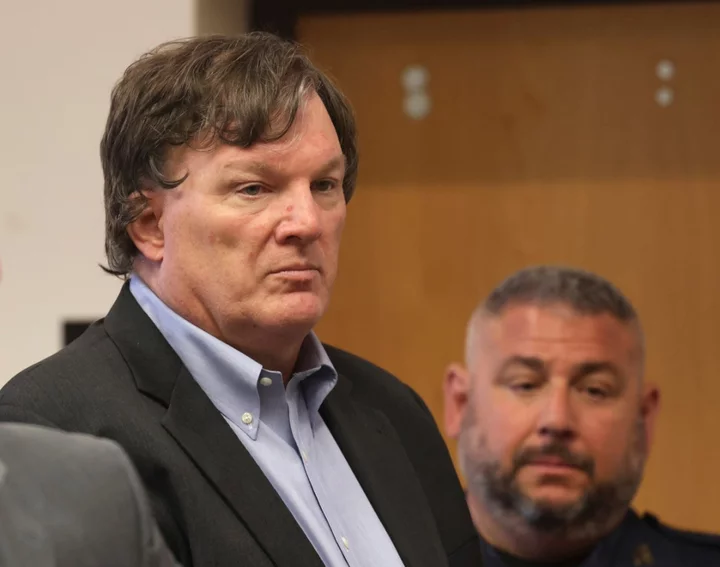
Gilgo Beach murders victim Jane Doe 7 identified as Karen Vergata 26 years after remains discovered
The Gilgo Beach murders victim previously known only as Jane Doe 7 has finally been identified more than 26 years after her partial remains were first discovered along the Long Island shores. Karen Vergata, a 34-year-old woman who was last seen alive in Manhattan in 1996 while working as an escort, was named on Friday by Long Island officials. The huge breakthrough in the case comes almost three decades after some of her remains were first discovered – and weeks after 59-year-old father-of-two architect was arrested and charged with the murders of three other victims. It was 20 April 1996 when the woman’s legs were found wrapped in plastic at Davis Park on Fire Island’s Blue Point Beach. Almost exactly 15 years later on 11 April 2011, the woman’s skull was then found off Ocean Parkway during the search for Gilgo Beach victims. The skull was located close to the remains of another also unidentified victim – Jane Doe 3, also known as Peaches. The two sets of remains were found to belong to the same person. Before now, investigators had been unable to identify Jane Doe 7 – also dubbed Fire Island Jane Doe. She was described only as a white woman aged 18 to 50 years old who had several notable scars including evidence of surgery on her left ankle. In total, the remains of 11 victims were found dumped along the shores of Gilgo Beach back in 2010 and 2011 but, more than a decade later, several are yet to be identified. This major development comes as prosecutors are seeking to obtain a swab of DNA from Rex Heuermann, the man arrested and charged with the murders of three of the victims and suspected of a fourth killing. In a court filing this week, prosecutors said that the DNA sample would “provide further relevant evidence of the defendant’s identity as the perpetrator of the crime”. Prosecutors have so far obtained hundreds of hours of footage from the suspect’s home in Massapequa Park and his office in Midtown Manhattan, 2,500 pages of documents, crime scene photographs and autopsy reports in the high-profile case. The trove of evidence was turned over to Suffolk County Supreme Court Justice Timothy Mazzei and Mr Heuermann’s attorney Michael Brown on Tuesday as the accused killer appeared in court for a brief preliminary hearing. Suffolk County DA Tierney said last week that a “massive amount of evidence” had been recovered from the home which Mr Heuermann grew up in as a child – and which he went on to share with his family up until his sudden arrest. No human remains were discovered, but a trove of around 270 guns were seized from the home. The DA previously revealed that they believe at least some of the murders may have taken place inside the home. Mr Heuermann’s wife and two adult children were out of town at the time of each of the three murders he is charged with, according to court records. The 59-year-old architect was taken into custody on 13 July, almost 13 years after the bodies of at least 11 victims were discovered along the shores of Gilgo Beach on Long Island. He was charged with the murders of Megan Waterman, Melissa Barthelemy and Amber Costello. He is also the prime suspect in the murder of Maureen Brainard-Barnes – who was last seen alive in early June 2007 in New York City and who, with the three other women, is known as the “Gilgo Four”. All four women worked as sex workers and disappeared after going to meet a client. They were all found in December 2010 within one-quarter mile of each other, bound by belts or tape and some wrapped in burlap – their bodies dumped along Gilgo Beach. They are among 11 victims whose remains were found along the shores of Long Island in 2010 and 2011, sparking fears of one or more serial killers. As well as looking into his connection to the murder of Brainard-Barnes and the other Gilgo Beach victims, law enforcement agencies are now also looking into unsolved murders and missing persons cases all across the country. Police in Las Vegas and South Carolina – where Mr Heuermann owns properties – and Atlantic City – where several sex workers have been found murdered – have confirmed they are eyeing the suspect in cold cases. Court records show that Mr Heuermann was linked to the “Gilgo Four” murders through a tip about his pickup truck, a stash of burner phones, “sadistic” online searches, phone calls taunting victims’ families, his wife’s hair found on the victims’ bodies – and a pizza crust. The first piece of the puzzle came when a witness in the Amber Costello case revealed details about a vehicle that a client was driving when she was last seen alive. Costello, who worked as a sex worker, was seen alive on the evening of 2 September 2010 when she left her home in West Babylon. A witness said she had gone to meet a client who was driving a first-generation Chevrolet Avalanche. Last year, a registration search showed that local man Mr Heuermann owned a first-generation model of the truck at the time of Costello’s disappearance. He also matched the witness’ description of the man believed to be the killer: a large, white “ogre”-like male in his mid-40s, around 6’4’ to 6’6” tall, with “dark bushy hair,” and “big oval style 1970’s type eyeglasses”. The discovery of the car led investigators to hone in on Mr Heuermann including executing 300 subpoenas, search warrants and other legal processes to obtain evidence to determine his potential involvement in the killings. Among this was Mr Heuermann’s alleged use of burner phones, with prosecutors saying that he used burner phones to contact the three women and arrange to meet them at the time when they went missing. He also allegedly took two of the victims’ cellphones – and used one to make taunting phone calls to one of their families where he boasted about her murder, court documents state. Mr Heuermann’s DNA was found on one of the victims, while his wife’s hair was found on three of the four women he is connected to. Following his arrest, his wife Asa Ellerup filed for divorce. She has since told The New York Post that she has been left filled with “anxiety” and their two children “cry themselves to sleep” over the horror. “I woke up in the middle of the night, shivering... anxiety,” she said. “My children cry themselves to sleep. I mean, they’re not children. They’re grown adults but they’re my children, and my son has developmental disabilities and he cried himself to sleep.” Mr Heuermann’s sudden arrest comes after the horrific serial killer case has captured the nation’s attention for more than a decade. The Gilgo Beach murders had long stumped law enforcement officials in Suffolk County who believed it could be the work of one or more serial killers who targeted sex workers and dumped their bodies along the remote beaches on Ocean Parkway. The case began in May 2010 when Shannan Gilbert vanished after leaving a client’s house on foot near Gilgo Beach. She called 911 for help saying she feared for her life and was never seen alive again. During a search for Gilbert in dense thicket close to the beach, police discovered the remains of another woman. Within a matter of days, the remains of three more victims were found close by. By spring 2011, the remains of a total of 10 victims had been found including eight women, a man, and a toddler. Police have long thought that it could be the work of one or more serial killers. Gilbert’s body was then found in December 2011. Her cause of death is widely contested with authorities long claiming that it is not connected to the serial killer or killers but that she died from accidental drowning as she fled from the client’s home. However, an independent autopsy commissioned by her family ruled that she died by strangulation and her mother believes she was murdered. Like Gilbert, most of the victims targeted were sex workers, while some are yet to be identified. Read More Rex Heuermann press conference – live: Long Island police to give ‘update’ in Gilgo Beach murders case Gilgo Beach serial killer suspect’s contact with wife revealed Daughter of Happy Face Killer launches GoFundMe for Gilgo Beach murders suspect’s wife
2023-08-04 22:48
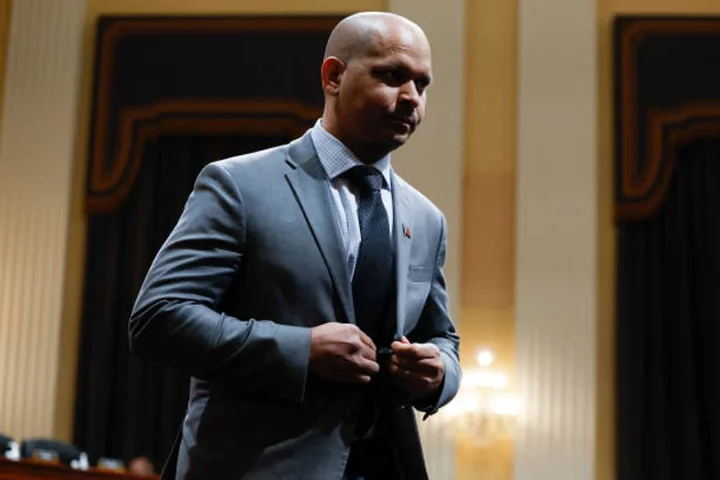
Capitol police sergeant injured on Jan 6 praises Trump arraignment: ‘Our democracy is worth fighting for’
When Donald Trump pleaded not guilty after being arrested and arraigned on Thursday for conspiring to overturn the 2020 presidential election, among those present in the courthouse was Aquilino Gonell. A US Capitol police officer, Mr Gonell resigned in December last year as he sought to continue recovering both “physically and mentally” from the trauma of the Jan 6 insurrection that occurred in 2021. “Our Democracy is worth fighting for,” the retired officer injured in the Capitol riot wrote on X (formerly Twitter) soon after the proceeding. “Not prosecuting is far riskier than having no consequences for the alleged power grab attempts. Justice and the rule of law must win for our democracy to survive,” he said of the former president who was indicted Monday on four charges as part of special counsel Jack Smith’s investigation into the alleged conspiracy surrounding the events from 6 Jan Capitol riot. Describing the incident, he wrote, “[As] Capitol Police sergeant, I found myself defending everything I sacrificed, and our very own democracy when it was threatened by an all out assault by a mob.” “As an American, the events on January 6 were shocking,” he said. “I was attacked by more than 50 people (one way or another) that I know of. I have given testimony to the congressional committee, investigators, prosecutors and the court.” He had earlier last year, while providing testimony before Congress, compared the experience of being at the Capitol on that day to his experience in Iraq with the US Army. “On January 6, for the first time, I was more afraid working at the Capitol than during my entire Army deployment to Iraq,” he had said in prepared remarks. “In Iraq, we expected armed violence, because we were in a war zone. But nothing in my experience in the Army, or as a law enforcement officer, prepared me for what we confronted on Jan 6.” He told legislators how he was punched, pushed, kicked, shoved, sprayed with chemical irritants and “blinded with eye-damaging lasers” – injuries that required multiple surgeries and a six-month medical leave. In a poetic twist of fate, Mr Trump’s latest arraignment brought him to the exact same courthouse where hundreds of people have been tried, convicted and sentenced to terms in prison as long as 18 years for charges in connection with the Jan 6 insurrection. Mr Trump, the man Liz Cheney once credited with having “assembled” and “summoned” members of the mob, is now the latest defendant among them. Mr Gonell was present in court along with two other police officers – Daniel Hodges and Harry Dunn – who defended the Capitol that day. They watched the former president’s arraignment from inside the court. Taking stock of the location’s symbolism where Mr Trump was produced, Mr Gonell said: “The same court in which hundreds of rioters have been sentenced. It’s the same court former President Trump is being arraigned in today for his alleged involvement before, during, and after the siege.” Read More Live updates: Trump pleads not guilty at arraignment in 2020 election case Trump pleaded not guilty. The stakes couldn’t be higher Trump was told not to talk to witnesses in 2020 election conspiracy case. That could be a challenge. Trump appears to stumble over his name and age at arraignment Watch view of the Capitol on day Donald Trump scheduled to be arraigned Trump supporters falsely claim former president faces death penalty
2023-08-04 17:21

Niger media guide
An overview of the media in Niger, including links to broadcasters and newspapers.
2023-08-04 16:57

Canadian province Alberta cancels bid for 2030 Commonwealth Games
It comes weeks after the Australian state of Victoria pulled out of hosting the 2026 Games.
2023-08-04 16:51
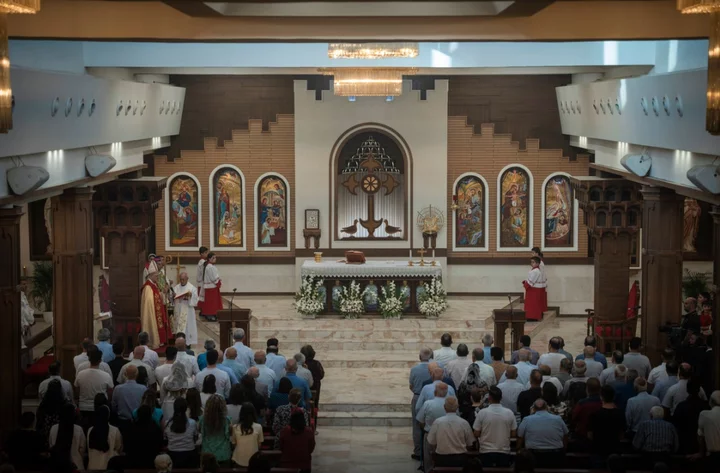
A feud between a patriarch and a militia leader adds to the woes of Iraqi Christians
Iraqi Christians have struggled since the Nineveh plains, their historic homeland of rolling hills dotted with wheat and barley fields, were wrested back from Islamic State extremists six years ago. Although the threat from IS has receded, some towns are still mostly rubble. There are few inhabited homes or basic services, including water. Many Christians have given up and left for Europe, Australia or the United States. Others are trying to follow. Now the shrinking religious minority that was also violently targeted by al-Qaida before the rise of IS has been rocked by yet another crisis in the form of a political showdown between two influential Christian figures — a Vatican-appointed cardinal and a militia leader, with land and influence at the core of the drama. The dispute adds to the woes of Iraqi Christians, who have often felt sidelined in the political order. A 2021 visit by Pope Francis provided a glimmer of hope that quickly faded. Meanwhile, the Christian population has plummeted. The number of Christians in Iraq today is estimated at 150,000, compared to 1.5 million in 2003. Iraq’s total population is more than 40 million. The political tension rose last month when Cardinal Louis Sako withdrew from his headquarters in Baghdad to northern Iraq’s semi-autonomous Kurdish region after Iraqi President Abdul Latif Rashid revoked a decree recognizing his position as patriarch of the Chaldeans, Iraq’s largest Christian denomination and one of the Catholic Church’s eastern rites. Sako said he will not return to Baghdad until his recognition is reinstated. His departure added to the feeling of helplessness among many Christians. “Of course, this affects us psychologically,” said Sura Salem, a Christian social activist in Baghdad. “You feel like a family without a father.” Christians staged a small protest in Baghdad over Sako’s departure, but Salem said “listening to the voice of the Christians is the last concern” of Iraqi leaders. Sako blames a campaign against him by Rayan al-Kildani, a fellow Chaldean Christian who formed a militia called the Babylon Brigades that fought against IS and still patrols much of the Nineveh plains. The group is affiliated with the Popular Mobilization Forces, a collection of primarily Shiite, Iran-backed militias. Its associated political party, the Babylon Movement, won four of five Christian-designated seats in Iraq’s 2021 parliamentary elections. Sako believes al-Kildani is angling to take over Christian endowments and properties. Al-Kildani has made similar allegations about Sako. “I have stood up to this militia and others who wanted to take over what rightfully belongs to the Christians,” Sako told The Associated Press, days after arriving in Irbil to a warm welcome from Kurdish officials. “Of course, no one defends Christians other than the church.” In Baghdad's upscale Mansour neighborhood, al-Kildani was busy building political alliances. On a recent afternoon, several couches in the palatial lobby of his party headquarters were occupied by well-dressed women wearing hijabs, beneath a painting of the Last Supper and a portrait of al-Kildani. One by one, the women entered the inner office, each one emerging with a gift bag. One of the visitors explained that they were political candidates interested in running on al-Kildani’s list in Mosul in December’s provincial elections. After the visitors departed, a smiling and courtly al-Kildani made his entrance. He insisted that he had no role in the withdrawal of the patriarch's decree and dismissed allegations that he was seeking to seize church lands. “I am the son of this church, and it is my duty to respect it, but it is unfortunate when a clergyman accuses someone without proof,” he said. Al-Kildani has accused Sako of selling off church properties, allegations the patriarch denies, and he has filed a lawsuit against Sako alleging slander. But al-Kildani said he is ready to meet with Sako to reconcile. Sako rejected the suggestion. Al-Kildani ”has a militia, and his loyalty is not to the church,” the patriarch said. “He is not a respectable person." The Iraqi president has downplayed his revocation of Sako's recognition as bureaucratic housekeeping, claiming it did not diminish the patriarch’s legal or religious status. The Vatican has remained largely silent. Its embassy in Baghdad said in a statement that the Iraqi Constitution guarantees that the heads of churches can administer church properties. A senior Vatican official, who spoke on condition of anonymity because he was not authorized to comment to the media, said the decree was unnecessary given the constitutional guarantees. He said the Holy See did not want to get involved in the dispute but had invited Sako to tamp down tensions with the Iraqi authorities for the sake of Iraqi Christians. The United States sided with Sako. State Department spokesman Matthew Miller said last month that the U.S. is concerned that Sako’s position "is under attack” by a militia leader who in 2019 was slapped with U.S. sanctions for his alleged involvement in human rights abuses, including cutting off a captive’s ear. Al-Kildani denied the allegations and accused the international community of being ungrateful after his group’s role in the fight against IS. He accused the Kurdish Democratic Party — the ruling party in the Kurdish region and a rival of the Iraqi president's Patriotic Union of Kurdistan Party — and the United States of engineering Sako’s withdrawal from Baghdad for political reasons. For some Christians, the drama is overshadowed by more pressing problems. As Baghdad resident Anan al-Dawi left a sparsely attended Mass on Sunday, her main concern was a recent power outage in the scorching summer heat. She struck a diplomatic tone regarding the feud between Sako and al-Kildani. Although physically absent, she said, Sako “lives in all of our hearts.” As for al-Kildani's group, she said: “I serve the country in my way. You serve it in yours, and they are also serving their country." Back in the Nineveh plains, in the town of Batnaya, patrolled by members of Kildani's militia, Lawrence Sabah owns a small factory where he makes mop handles out of wood imported from Russia. Sabah did not share his opinion on Sako or al-Kildani, but he had other complaints. “There are no services, even the water sometimes doesn’t come, and 70 or 80 percent of the houses were destroyed,” he said. He is hoping to join his parents and siblings, who have resettled in California. Some 8 kilometers (5 miles) to the north, in Kurdish-controlled territory, Raad Ekram owns an electrical supply store in the sparsely populated town of Telskof. When his family was displaced from the village to the city of Dohuk, Ekram believes he got short shrift from both the Iraqi government and the church. “We never saw the patriarch,” he said. “Of course, I don’t accept what happened to him ... and I don’t accept for him to be harmed.” But the patriarch "didn’t do everything he should have done for us.” He is encouraging his children to seek their fortunes abroad. “There’s nothing left in Iraq," he said, "especially for the Christians.” ___ Associated Press writers Nicole Winfield in Rome and Matthew Lee in Washington contributed to this report. ___ Associated Press religion coverage receives support through the AP’s collaboration with The Conversation US, with funding from Lilly Endowment Inc. The AP is solely responsible for this content. Read More Ukraine war’s heaviest fight rages in east - follow live Charity boss speaks out over ‘traumatic’ encounter with royal aide Biden's inaction on death penalty may be a top campaign issue as Trump and DeSantis laud executions On 3rd anniversary, Beirut port blast probe blocked by intrigue and even the death toll is disputed Mega Millions players will have another chance on Friday night to win a $1.25 billion jackpot
2023-08-04 13:50

Trump appears to stumble over his name and age at arraignment
Donald Trump appeared to stumble over his words when he was asked to state his full name and age at his arraignment on charges of attempting to overturn the 2020 election. Mr Trump arrived at the E Barrett Prettyman federal courthouse in Washington DC on Thursday where he pleaded not guilty to four criminal counts of an alleged election hoax conspiracy that led to the January 6 riots at the US Capitol. Mr Trump, dressed in his trademark navy blue suit and red tie, entered the courtroom at 3.51pm accompanied by John Lauro, a veteran Washington-based criminal defence attorney, and Todd Blanche, the New York-based lawyer who is leading his defence in the other criminal cases against him. He was made to wait about 25 minutes before the magistrate judge entered the room at 4.15pm, and appeared nervous and fidgety. After attorneys for the government and defence introduced themselves, Mr Trump stood to take his oath from a courtroom deputy. US Magistrate Judge Moxila Upadhyaya then asked the former president to state his full name. “Donald J Trump — John — Donald John Trump,” Mr Trump replied hesitantly. He was then asked for his date of birth, and tripped over his words again. At first, he said “seven seven,” before correcting himself and saying “77”. After explaining his rights to remain silent and to legal representation, and reminding him of the lengthy prison sentence he faces if convicted, Judge Upadhyaya asked Mr Trump if he understood. He replied in the affirmative. Mr Lauro then entered a plea of not guilty on all counts on his behalf. Prosecutors did not seek to detain Mr Trump, and set a date of 28 August for a first hearing before Judge Tanya Chutkan. Mr Trump is not required to attend. In comments to reporters afterwards, Mr Trump described it as a “very sad day” before claiming Washington DC had deteriorated in the two and a half years since he left office. “This was never supposed to happen in America.... if you can’t beat ‘em, you persecute them,” he said. As his motorcade returned to Ronald Reagan Washington National Airport, it was met with a chorus of insults from a small group of protesters. “F** you, terrorist,” one man yelled, according to Wall Street Journal reporter Andrew Restuccia. Earlier this week, Mr Trump was charged with conspiracy to defraud the United States, witness tampering, conspiracy against the rights of citizens, and obstruction of and attempt to obstruct an official proceeding in relation to his attempts to overturn the results of the 2020 presidential election. The indictment also described six unnamed co-conspirators, who have been identified from details contained in the document as New York City Mayor Rudy Giuliani, former Mr Trump lawyer John Eastman, “Kraken” lawyer Sidney Powell, former top Justice Department official Jeffrey Clark, and attorney Kenneth Chesebro. Mr Trump has claimed in a series of unhinged posts to Truth Social that President Biden and the US Department of Justice had “weaponised” the federal government against him. Read More Live: Trump pleads not guilty at arraignment after arrest Trump pleads not guilty to federal conspiracy charges in plot to overturn 2020 election Who is Jack Smith? The special prosecutor who just indicted Trump again
2023-08-04 12:58
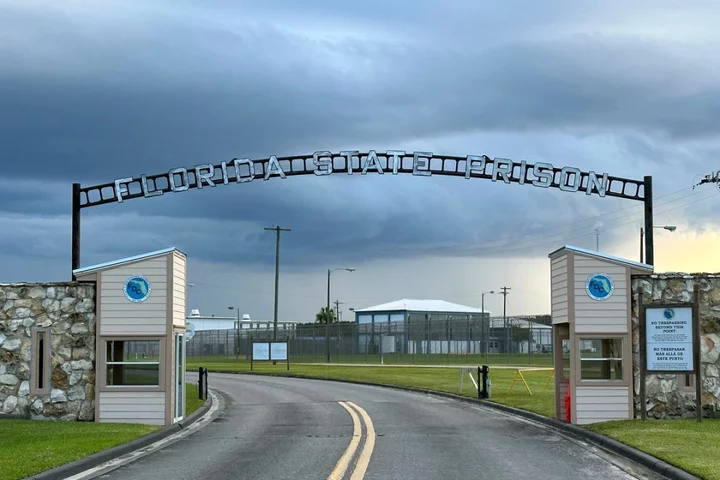
Florida executes man for 1988 murder of nurse who was sexually assaulted, killed with hammer, set on fire
A Florida man who recently dropped all legal appeals was executed Thursday for the 1988 murder of a woman who was sexually assaulted, killed with a hammer, and then set on fire in her own bed. James Phillip Barnes, 61, was pronounced dead at 6.13pm following a lethal injection at Florida State Prison in Starke. Lying on a gurney, Barnes appeared to already have his eyes shut when the curtain was opened for witnesses. He didn't respond when prison officials asked if he had a final statement, and he remained motionless except for breathing for about 10 minutes until that stopped. A doctor then pronounced him dead. The 61-year-old inmate was sentenced to death for the murder of nurse Patricia “Patsy” Miller. It was the fifth execution in Florida this year. One of the victim's siblings, Andrew Miller, witnessed the execution and said he came to remember his sister. “I did not come here to watch someone die. I came here to honor our sister, Patricia Miller,” he told reporters afterward. “No one should live in fear within the safety of their own home. No woman, no child, no animal should have that fear. We did.” Barnes was serving a life sentence for the 1997 strangulation of his wife, 44-year-old Linda Barnes, when he wrote letters in 2005 to a state prosecutor claiming responsibility for killing Miller years earlier at her condominium in Melbourne on Florida’s east coast. Barnes represented himself in court hearings where he offered no defense, pleaded guilty to killing Miller and did not attempt to seek a life sentence rather than the death penalty. Miller, who was 41 when Barnes killed her on April 20, 1988, had some previous unspecified negative interactions with him, according to a jailhouse interview he gave German film director Werner Herzog. “There were several events that happened (with Miller). I felt terribly humiliated, that’s all I can say,” Barnes said in the interview. When he pleaded guilty, Barnes told the judge that after breaking into Miller’s unit, “I raped her twice. I tried to strangle her to death. I hit her head with a hammer and killed her and I set her bed on fire,” according to court records. There was also DNA evidence linking Barnes to Miller’s killing. After pleading guilty, Barnes was sentenced to death on 13 December 2007. He also pleaded guilty to sexual battery, arson, and burglary with an assault and battery. Barnes killed his wife in 1997 after she discovered that he was dealing drugs. Her body was found stuffed in a closet after she was strangled, court records show. Barnes has claimed to have killed at least two other people but has never been charged in those cases. Barnes had been in and out of prison since his teenage years, including time served for convictions for grand theft, forgery, burglary and trafficking in stolen property. In the Miller case, state lawyers appointed to represent Barnes filed initial appeals, including one that led to mental competency evaluations. Two doctors found that Barnes had symptoms of personality disorder with “borderline antisocial and sociopathic features.” However, they pronounced him competent to understand his legal situation and plead guilty, and his convictions and death sentence were upheld. After DeSantis signed the inmate’s death warrant in June, a Brevard County judge granted Barnes’ motion to drop all appeals involving mitigating evidence such as his mental condition and said “that he wanted to accept responsibility for his actions and to proceed to execution (his death) without any delay,” court records show. Though unusual, condemned inmates sometimes don’t pursue every legal avenue to avoid execution. The Death Penalty Information Center reports that about 150 such inmates have been put to death since the US Supreme Court reaffirmed the death penalty as constitutional in 1976. The Florida Supreme Court accepted the Brevard County ruling, noting that no other motion seeking a stay of execution for Barnes had been filed in state or federal court. In the Herzog interview, Barnes said he had converted to Islam in prison and wanted to clear his conscience about the Miller case during the holy month of Ramadan. “They say I’m remorseless. I’m not. There are no more questions on this case. And I’m going to be executed,” Barnes said. Read More Grieving families confront Pittsburgh synagogue shooter at death penalty sentencing Singapore executes third prisoner in just 8 days. What explains this fresh wave of death sentences? Robert Bowers killed 11 in a Pittsburgh synagogue shooting. A jury ruled that he deserves death
2023-08-04 11:58

The son of Colombia's president says his father's election campaign received money of dubious origin
The son of Colombian President Gustavo Petro acknowledged Thursday that his father’s 2022 election campaign received money of dubious origin, according prosecutors investigating the son for alleged illicit enrichment and money laundering. Nicolás Petro, who was a legislator representing a northern coastal region, agreed to cooperate with prosecutors in the probe after being charged Tuesday. Prosecutor Mario Andrés Burgos, who heads the investigation, said the younger Petro has revealed that unjustified increases detected in his assets came from two individuals being questioned by Colombian authorities. The money went partly into his own accounts and partly into the campaign that made his father Colombia's first elected leftist president, the prosecutor said. On Tuesday, when he was charged, prosecutors said the younger Petro took thousands of dollars from drug traffickers and used it to buy luxurious homes and expensive cars. Nicolás Petro, 36, pleaded innocent to the charges, but agreed to cooperate with authorities. The case has come at a time when Colombia’s president is losing popularity and has been exposed to attacks by opposition parties, which have become increasingly reluctant to cooperate with his legislative agenda. The investigation stems from a shocking declaration made by the son's former wife, Daysuris Vásquez, to local news magazine Semana in March. Vasquez said she was present at meetings where Nicolás Petro arranged a 600 million peso ($150,000) donation from a politician who was once convicted in Washington of drug trafficking and who wanted to contribute to Gustavo Petro’s 2022 presidential campaign. She accused her ex-husband of pocketing the money and said that the father’s presidential campaign had no knowledge of the donation. On Thursday, prosecutors said the “resources” in the case were around $270,000 that was delivered by Samuel Santander Lopesierra and Gabriel Hilsaca to Nicolás Petro. Lopesierra was convicted and extradited to the United States, where he was sentenced for drug trafficking. Hilsaca is the son of Alfonso Hilsaca, who is currently being prosecuted on charges of murder and criminal conspiracy in Colombia. Burgos said the president’s son has promised to deliver audio recordings and documentary evidence that would corroborate that part of the money he received was used to finance his father’s electoral campaign without being duly reported to authorities.. Prosecutors also accused Vásquez of co-operating in the money laundering scheme and said she helped her husband hide thousands of dollars in cash in suitcases that the couple kept at their home. The couple, who no longer live together, were arrested Saturday and have been held at the headquarters of the Chief Prosecutor’s Office in Bogota. Thursday’s hearing was held to hear arguments on whether Nicolás Petro’s detention should be switched to house arrest. The president has said he would not interfere with the investigation, and wrote a message on X, the platform formerly known as Twitter, in which he said he hoped his son would “reflect on his mistakes.” Read More Ukraine war’s heaviest fight rages in east - follow live Charity boss speaks out over ‘traumatic’ encounter with royal aide Panama Canal foresees its income falling after shipping limited due to a drought Appeals court allows Biden asylum restrictions to temporarily stay in place as case plays out New Zealand to boost its defense capabilities as it faces increasing tensions in the Pacific
2023-08-04 09:22

Trump pleads not guilty to federal conspiracy charges in plot to overturn 2020 election
Donald Trump has pleaded not guilty to four criminal charges stemming from his attempt to overturn the election he lost to Joe Biden less than three years ago. Mr Trump entered his plea on the second-floor courtroom at the E Barrett Prettyman Courthouse in Washington DC on 3 August, just a short walk from where a mob of his supporters began assaulting police officers at the start of the January 6 attack on the US Capitol. The twice-impeached, now-thrice-indicted ex-president’s appearance in criminal court – his third since April – comes just two days after a Washington DC grand jury charged him with three criminal conspiracies and obstruction in connection with his attempts to overturn the results of the 2020 presidential election. In a poetic twist of fate, Mr Trump’s latest arraignment brought him to the exact same courthouse where hundreds of people have been tried, convicted and sentenced to terms in prison as long as 18 years for charges in connection with January 6. Mr Trump, the man Liz Cheney once credited with having “assembled” and “summoned” members of the mob, is now the latest defendant among them. Three police officers who defended the Capitol that day – Daniel Hodges, Aquilino Gonnell and Harry Dunn – watched the former president’s arraignment from inside the court. “All I have wanted from day one is accountability,” Mr Dunn said in a statement through his attorney. Mr Trump was accompanied by John Lauro, a veteran Washington-based criminal defence attorney, and Todd Blanche, the New York-based lawyer who is leading his defence in the other criminal cases against him. The former president – wearing his customary red tie, white shirt and dark blue suit – sat impassively between his attorneys, while US Department of Justice special counsel Jack Smith was seen glancing at the defendant and counsel as the courtroom waited for the arrival of US Magistrate Judge Moxila A Upadhyaya. The court proceedings began at 4.15 pm, with the courtroom standing for the magistrate judge’s entrance. After attorneys for the government and defence introduced themselves, Mr Trump was asked to swear to tell the truth, the whole truth and nothing but the truth, and the judge reminded participants and media of court rules against recording. Mr Trump was then asked to state his full name: “Donald J Trump – John – Donald John Trump.” Asked for his age, he at first said “seven seven,” then corrected himself and said “77”. After Judge Upadhyaya read the charges and explained the penalties Mr Trump could face if convicted, she advised the ex-president – who she addressed as “Mr Trump” – of his right to remain silent, and his right to an attorney. After explaining each right, she asked if he understood. Each time, he replied: “Yes” or “yes, I do”. Mr Lauro, the attorney for the ex-president, entered a plea of not guilty on all counts on his behalf. Judge Upadhyaya warned Mr Trump that the “most important” condition of his release is that he not commit any crimes while awaiting trial, and said he could face pretrial detention or harsher sentences if he violates that condition. She also warned him of the consequences of failing to appear for future court dates, and specifically cautioned Mr Trump against intimidating, retaliating, or trying to influence any witness in the case against him. Asked if he would comply, the ex-president appeared to answer in the affirmative, at which point the judge ordered a pretrial services officer to swear him to abide by the conditions, which he then signed in the magistrate judge’s presence. Judge Upadhyaya then offered both sides several potential dates for the next hearing in the case, which she said she had come up with after consulting with Judge Tanya Chutkan, the district judge overseeing the case. While the magistrate judge set the next hearing for 28 August, she said Mr Trump is not required to appear, and ordered the government to file a proposed schedule and state how many days it expects to need for trial within seven days. She also ordered the defence to file a response seven days after that. Mr Lauro said the defence would need “an understanding of the magnitude of discovery,” including possible “exculpatory information” before being able to state when Mr Trump would be ready for trial. “There’s no question in my mind that Mr Trump is entitled to a fair and just trial,” he said, adding that he would like information on the “scope and extent” of evidence within two or three days. Mr Windom said in response that the government would “endeavour” to get the materials to defence “very, very quickly” after an appropriate protective order is entered. He added that the case would benefit from “normal order” and “a speedy trial,” after which Judge Upadhyaya said there would be a fair process for both sides. The magistrate judge added that Judge Chutkan intends to set a trial date at the 28 August hearing. Mr Lauro then rose again to suggest that he and his co-counsel could not say when they’d want a trial until after the discovery is turned over, but Judge Upadhyaya said her order for a response from the defence seven days after the government’s proposal would stand. In response, Mr Lauro then told the magistrate judge that it was “somewhat absurd” for the trial to take place within the time frame laid out under the Speedy Trial Act, and suggested that all he is seeking is “a little time”. Judge Upadhyaya then ordered Mr Lauro to file his request to “toll” the Speedy Trial Act’s requirements in a written motion within five days. A relatively small number of pro- and anti-Trump demonstrators joined the dozens of news outlets and makeshift studios on the courthouse grounds. Law enforcement agencies erected temporary barriers around the building and surrounding streets. Many of the pro-Trump figures who came to Washington appeared to be from the same group of die-hard supporters who flocked to his prior federal arraignment in Miami, including members of the “Blacks for Trump” group often seen behind him at his campaign rallies. Another recognisable personality who came to the courthouse was Randy Credico, a comedian and radio host who gained a measure of prominence when he was a witness at the 2019 trial of longtime Trump associate Roger Stone on charges that the veteran GOP operative lied to Congress and committed witness tampering by threatening to harm Mr Credico’s emotional support dog, a Havanese called Bianca. Mr Stone, who was convicted of those charges, was later pardoned by Mr Trump before he left office. The latest criminal charges against Donald Trump The latest four-count indictment against Mr Trump alleges four crimes: conspiracy to defraud the United States, conspiracy to obstruct an official proceeding, obstruction and attempt to obstruct an official proceeding, and conspiracy against rights. The indictment also lists six unnamed co-conspirators, including Trump-linked attorneys and Justice Department officials. Prosecutors have outlined a multi-state scheme built on Mr Trump’s legacy of lies and conspiracy theories to undermine the democratic process, culminating with an attack on the US Capitol fuelled by that same baseless narrative. According to prosecutors, then-President Trump and his allies conspired with officials in states that he lost to invalidate ballots and use fraudulent electors to cast their electoral college votes on his behalf, relied on the Justice Department to implement the plan, and pressured then-Vice President Mike Pence to certify what was a fraudulent outcome when he presided over a joint session of Congress on 6 January, 2021. After Mr Pence refused, Mr Trump and his alleged co-conspirators “exploited” the chaos from a mob of his supporters to delay the certification and make a last-ditch effort to reverse the results, according to the indictment. “Despite having lost, [Mr Trump] was determined to remain in power,” the indictment states. “These claims were false, and the Defendant knew that they were false. In fact, the Defendant was notified repeatedly that his claims were untrue – often by the people on whom he relied for candid advice on important matters, and who were best positioned to know the facts – and he deliberately disregarded the truth.” Mr Trump and his allies and right-wing pundits have accused President Biden and the US Department of Justice of “weaponising” the federal government against the former president, cast as a victim of political persecution against his Democratic rival. They claim that the latest indictment is a threat to his First Amendment rights to refute his election loss. The indictment, crucially, states that Mr Trump has the right – “like every American” – to falsely state whatever he wants about the election, even to claim victory when in fact has not. What he cannot do, prosecutors argue, is weaponize those lies in a conspiracy to overturn the results. “Each of these conspiracies – built on the widespread mistrust [Mr Trump] was creating through pervasive and destabilizing lies about election fraud – targeted a bedrock function of the United States federal government,” according to the indictment. More criminal charges and trials ahead The case is far from Mr Trump’s only legal obstacle as he campaigns for the 2024 Republican nomination for president. Mr Trump faces two other criminal cases that are scheduled for trial next year. The first, starting March 2024, will be in his former home state of New York, where a Manhattan prosecutor in April charged him with falsifying business records in connection with hush money payments used to silence stories of his alleged affairs in the lead-up to his 2016 election, marking the first-ever criminal indictment of a former president. Two months later, he will appear in a South Florida federal courtroom to be tried on a 40-count federal indictment accusing him of illegally retaining classified documents at the Palm Beach mansion turned social club where he maintains his primary residence, and conspiring to obstruct a federal probe into his alleged unlawful retention of the documents with the aid of two co-conspirators. He has pleaded not guilty in both cases. Mr Trump, his three eldest children and his business empire also face a $250m lawsuit from New York Attorney General Letitia James following a three-year civil investigation into allegations of fraud. That case is expected to head to trial on 2 October. And in Georgia, a grand jury is hearing evidence and witness testimony surrounding a pressure campaign from Mr Trump and his allies to overturn 2020 election results in that state following a two-year investigation from Fulton County District Attorney Fani Willis. Ms Willis has indicated that potential charges stemming from that investigation would arrive this month. Read More Trump arraignment live updates: Trump heads to DC court to be arraigned for 2020 election charges Trump, January 6 and a conspiracy to overturn the 2020 election: The federal investigation, explained Eight key revelations from Trump’s January 6 indictment Donald Trump’s latest indictment is a test for America Who are Trump’s six alleged co-conspirators in the 2020 election probe case?
2023-08-04 05:24
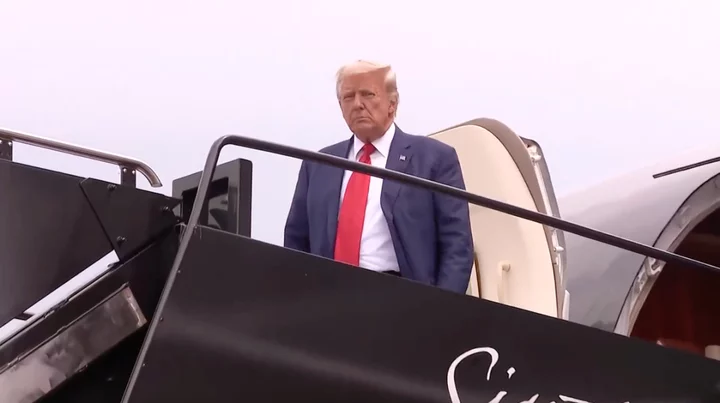
Live updates: Trump pleads not guilty at arraignment in 2020 election case
Donald Trump has pleaded not guilty after being formally arrested and arraigned for conspiring to overturn the 2020 presidential election, in what marks his third – and potentially most serious – criminal case. The former president was indicted on four charges by a grand jury hearing evidence in special counsel Jack Smith’s investigation into the alleged conspiracy to overturn the election and the resulting January 6 Capitol riot. The indictment also described six unnamed co-conspirators, now believed to be identified. Mr Trump made an initial appearance at the E Barrett Prettyman federal courthouse to enter his plea. The government did not seek detention. The former president has railed against the indictment and is calling for the “fake” case to be moved out of Washington DC where he claims it is “IMPOSSIBLE to get a fair trial”. He has also promised revenge for what he calls a politicised indictment of “concocted” charges ordered by “Crooked Joe Biden”. In a Truth Social post, he told supporters “IN 2024, IT WILL BE OUR TURN. MAGA!” The case has been assigned to US district judge Tanya Chutkan, a Barack Obama appointee. Read Trump’s full indictment from the January 6 grand jury Read More Will Donald Trump go to prison? Trump pleads not guilty to federal conspiracy charges in plot to overturn 2020 election Trump appears to stumble over his name and age at arraignment
2023-08-04 05:16
